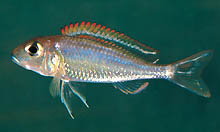WHAT'S NEW
ACROSS THE WORLD
Select date in side bar to go to a What's
New of previous issues
| What's New ©by
Laif DeMason
As winter begins to set in, hobbyists spend more time inside and out of the cold. With more time spent on our favorite hobby, comes the yearning for new fishes to play with. Why not plan ahead and take some time to make some more space to house some new species? Once some valuable space is acquired, now it is time to shop around. Take a trip to your favorite pet shop or local club. Maybe there is a larger aquarium show nearby or fish swap meet. Call some friends and organize a road trip! You’ll be glad you did. Seeing the fish before purchasing it is the best way. Have some fun this year!
Here’s “what’s new” on the cichlid
scene:
|
Lake Tanganyika
Tanganyika cichlids continue to flow from both the lake and from larger breeding operations. Interest is still keen for many of these fishes worldwide. Fortunately, material from Burundi is still available for the most part, and the exporters from Tanzania and Zambia are still active. Other than the extreme north, most African collecting teams may not always have the proper equipment and knowledge, thus only the hardiest fishes are currently harvested for sale.
|
what's
new: Lake Tanganyika
|

Collected recently in Magara, Burundi, Neolamprologus falcicula is available as wild caught items. Previously, another species, N. walteri, exported from Kigoma, Tanzania, was sold under this name, but is not the same fish.
|

Available infrequently from Zambia and Burundi, Ctenochromis horei has created some interest with specialty cichlids fans. Take care as they can be quite territorial as large adults. Photo by A. Konings.
|

Collected in southern Congo of late, Tropheus moorii Murago is not often available as wild adults. This individual sports the large spots on the face and head; however, the body color is lighter green than normal.
|

Often available in the past, but only occasionally offered now, Callochromis pleurospilus has recently been exported again from Burundi. Like many open sand fish, this beautiful fish colors up once they settle down. Photo by A. Konings.
|
Lake Malawi
A strong push from Tanzanian collectors has upped the ante of available species for export. Several hard to find items were collected and shipped. Malawi cichlid enthusiasts have been rewarded though the overall demand is still low for wild material. Newly bred items from the last few months are up to size and the main commercial breeding centers currently have good stocks and a wide selection.

Usually sold as ‘Tanzanian acei’, this Pseudotropheus elegans hails from near Itungi Port there. This form is darker purple-blue with a nice orange-colored caudal fin. |

Collected from Tumbi Reef, Tanzania, Labidochromis caeruleus ‘blue-white’ has no black markings. Females are white with faint bars; males are somewhat bluer. |

Seasonally found in southern Tanzania, Lethrinops sp. ‘longipinnis nketeke’ has arrived after a few years’ absence from the import scene. Wild males arriving in full color can be more than six inches long; the females are smaller. |

Usually exported from the Malawi coast, Mylochromis sp. ‘lateristriga makanjila’ were collected this time from Lundo Island, Tanzania and unlike usual, arrived in full color. |

Also from Tanzania, Tropheops sp. ‘mauve yellow’ Magunga is rarely exported. For dominant males, the orange coloration increases in intensity and area to nearly completely cover its body. Less dominant males are bluer with only orange heads. |

Lethrinops marginatus is exported from different places around the lake. Recent collections from Itungi Port arrived in full color and five inches in size. Note the red and blue striations in the caudal fin. |
Neotropics
A new collecting season has just begun in many of the South American exporting countries and fish exporting has been steady. Captive bred items from the usual places are also being sold and availabilities are good. So if your tastes include pikes, dwarf cichlids, discus, big guapotes, or the like, seek and you’ll find it!

A not often seen cichlid from Guatemala and southern Mexico is Astatheros nourissati. Named for its discoverer, Jean-Claude Nourissat, this fish is available from specialty breeders. Photo by A. Konings. |

The fish above is Paratheraps fenestratus “piebald”. The normal color pattern for this fish is colored blue and red. The piebald version can be white like the one pictured here, or more orange/red in coloration. |

One of the many new cichlids developed in the Far East is a mix of species called Jade Green. This fish is reportedly a throw-off from a Flowerhorn strain and very few perfect individuals are produced from any given spawn. |

Current strains of discus fish look quite different than any wild caught individual. All have been created by man by selective breeding. Here is a striking Pigeon Snake Skin strain with strong color and many striations. |
Select date in side bar to go a What's
New of previous issues
|













